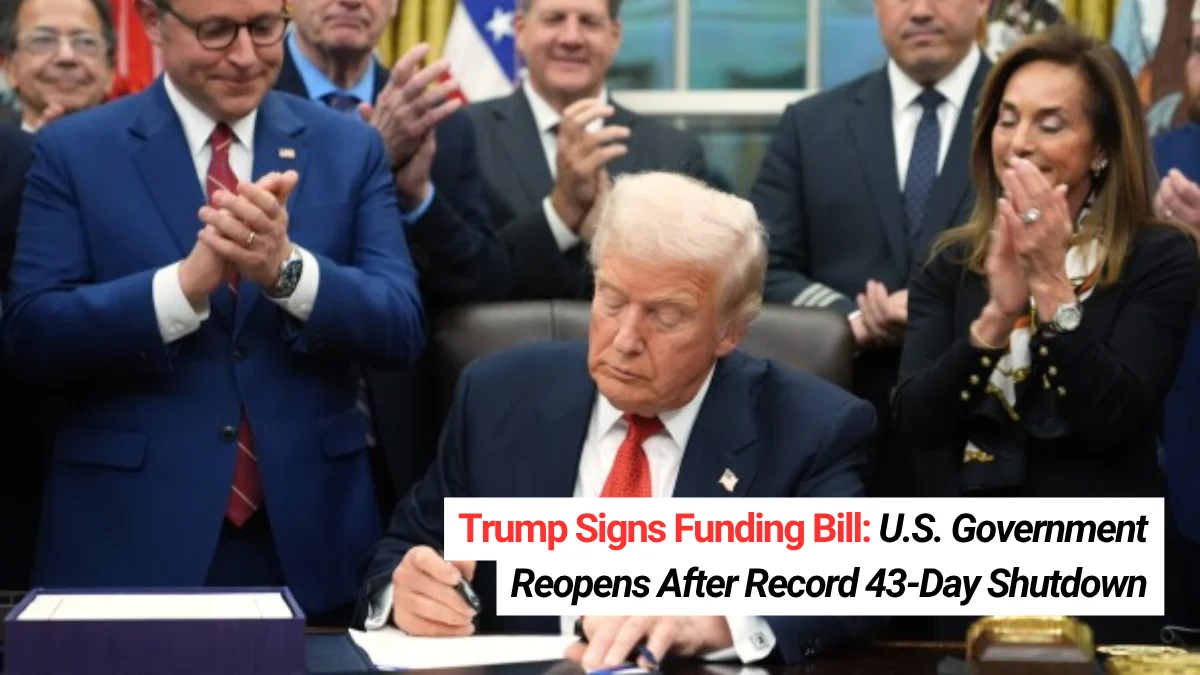After 43 long days of unpaid workers, shuttered parks, and halted services, the U.S. government has finally reopened. President Donald Trump signed a bipartisan funding bill late on November 12, 2025, ending what became the longest government shutdown in American history.
While federal employees return to work and essential services resume, the relief comes with a caveat. The bill does not include extensions for the Affordable Care Act (ACA) subsidies, raising concerns about potential health coverage losses. As Washington celebrates the deal, the next political showdown is already on the horizon.
Key Takeaways
- Next policy clash expected in December over ACA funding.
- 43-day shutdown ends after bipartisan vote in Congress.
- 1.4 million federal workers to receive full backpay.
- No Affordable Care Act subsidy extension included in the bill.
- $3–5 billion in estimated economic losses, per CBO.
The Shutdown’s Origin and Impact
The shutdown began on October 1, triggered by deep funding disagreements between the White House and Democratic leaders. President Trump sought tougher immigration provisions, while Democrats focused on extending ACA subsidies set to expire at year-end.
The stalemate came at a high cost. The Congressional Budget Office estimates $3–5 billion in lost output. Around 1.4 million federal employees missed paychecks, and airports reduced flight operations by 10% at major hubs. Long queues, delayed permits, and empty federal offices became symbols of the impasse.
For many, it was a reminder of the 35-day shutdown during Trump’s first term but this one lasted eight days longer, marking a new record. Public sentiment was evenly divided: 50% blamed Republicans, 47% blamed Democrats, according to a Reuters/Ipsos poll.
How the Deal Came Together
The compromise moved quickly once momentum shifted in the Senate. On November 10, the Senate approved the funding bill 60–40, with eight Democrats breaking ranks to end the gridlock. The House followed on November 12, passing the measure 222–209, and Trump signed it the same night at 10:24 p.m. ET.
The deal provides a temporary funding extension through January 30, 2026, ensuring that federal agencies remain operational while longer-term negotiations continue. The bill also restores all lost pay and reverses previous furlough terminations initiated during the shutdown.
Trump called the outcome a “very good deal for the American people,” while attributing the crisis to what he labeled Democratic “obstruction.” Despite the relief, the absence of ACA provisions has already set the stage for renewed clashes in Congress.
Breakdown of the Funding Package
The new “minibus” legislation groups three key funding areas together, maintaining essential programs through fiscal 2026.
| Component | Funding Duration | Key Benefits |
|---|---|---|
| General Government | Through Jan 30, 2026 | Full backpay for 1.4M workers; layoffs reversed |
| SNAP/Food Assistance | Through FY 2026 | Benefits resume fully; no legal interruptions |
| Military/VA | Through FY 2026 | Troops and veterans paid on time |
| Other Departments (Agriculture, FDA, etc.) | Through FY 2026 | Normal operations resume; no budget cuts |
This framework ensures the continuity of critical services. Furloughed federal employees about 670,000 are returning to their posts, while 730,000 essential staff who worked unpaid will receive retroactive compensation. SNAP users will see uninterrupted payments through September 2026, avoiding past disruptions.
Healthcare Clash: The ACA Subsidy Gap
Despite the bipartisan cooperation on spending, the Affordable Care Act remains the unresolved core issue. The bill did not include an extension for COVID-era ACA subsidies, which are set to expire December 31, 2025.
Without congressional action, health insurance premiums could rise sharply, with the CBO estimating 2 million Americans may lose coverage next year.
Democrats criticized the exclusion as a “moral failure,” arguing it puts middle-income families at risk.
Republicans, however, defended the move, calling for a “targeted” renewal with new income caps.
Senate GOP leaders have promised a December vote to revisit the subsidy structure, though divisions remain on both sides.
Economic and Social Impact
The end of the shutdown brings relief to federal employees, contractors, and millions dependent on public services.
Travel disruptions are expected to ease gradually, with the Transportation Department confirming full flight restoration before Thanksgiving.
Financial markets reacted positively U.S. stocks rose 1.2%, while Bitcoin climbed 2%, signaling improved investor confidence.
However, residual effects persist.
Low-income energy assistance remains delayed, and a new ban on hemp-derived THC products within the bill is expected to impact several state economies. Political observers warn that these side provisions could influence midterm election narratives next year.
What Lies Ahead
The reopening of government brings short-term relief but not resolution. Without an ACA compromise, a new funding impasse could emerge early next year.
President Trump’s approval rating among Republican voters reportedly rose after the deal, but national polls show public opinion split evenly between both parties for blame.
As operations resume, the broader question remains: Can Congress craft a sustainable budget path before January 30, 2026, or is another fiscal showdown already taking shape?









